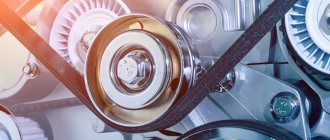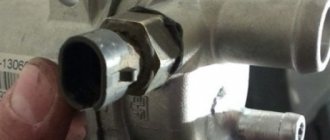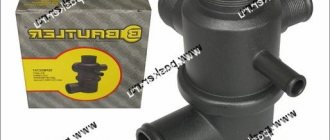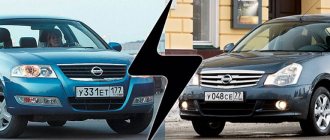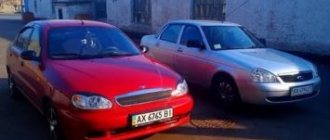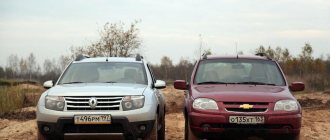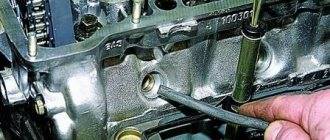Basic layouts with rear wheel drive: classic…
...mid-engine...
...and rear-engine.
See also category: Rear-wheel drive
Rear drive
- the design of a car transmission, when the torque generated by the engine is transmitted to the rear wheels.
This can be realized with very different relative positions of the engine and transmission units (see a number of illustrations on the right)
.
Rear-wheel drive is also used almost everywhere on motorcycles.
Advantages and disadvantages
Listed here are the advantages and disadvantages common to all rear-wheel drive layouts.
pros
- Dynamic loading of the rear (drive) axle: when you press the gas, the weight of the car is transferred to the rear, thereby loading the rear wheels and unloading the front ones. As a result, when accelerating, the car has better traction with the road surface, the drive wheels slip less, and engine thrust is used more efficiently during acceleration.[1] The result is good acceleration dynamics and the ability to confidently overcome inclines, even with insufficient engine power[2].
- Skidding in a rear-wheel drive car occurs at a lower critical speed than in the case of front-wheel drive or all-wheel drive, but is more predictable and can be easily eliminated either by releasing the gas (after a stall) or by pressing the clutch while simultaneously turning the steering wheel in the direction of the skid. It is better not to use braking in this case. An average driver in such situations is inclined to instinctively throw off the gas rather than press it.[1] With front-wheel drive, on the contrary, to get out of a skid you have to increase the force on the gas pedal, and dropping or braking will lead to an even greater loss of controllability - but at the same time, the skid itself occurs at a significantly higher speed.[1]
- No reaction torques are transmitted to the steering wheel during acceleration, since the front wheels are not driven.[3] (at present, we have learned to effectively deal with the transmission of torques to the steering with front-wheel drive, which manifests itself mainly in a scheme with a transverse engine arrangement and unequal length of the front wheel drive axle shafts);
- Smaller turning radius with equal wheelbase, since the steering angles of the front wheels are not limited by constant velocity joints.[2]
- A greater variety of control techniques - in particular, rear-wheel drive allows a specially trained driver to drive the car in a controlled drift, “playing” with the gas pedal with the steering wheel turned in the direction of the skid.
- The drive wheels follow a compacted track laid by the front driven wheels, due to which a rear-wheel drive vehicle has better cross-country ability on loose soils and snow; the drive axle is well loaded, which also contributes to cross-country ability, and as the rear-wheel drive vehicle is loaded with passengers and cargo, the adhesion weight on the drive axle increases, and therefore its cross-country ability increases.
Minuses
- All rear-wheel drive layouts are disadvantageous in terms of efficient use of space: with a classic layout, the ratio of the length of the car to its wheelbase is the least favorable; with a mid-engine layout, the engine takes up almost half of the passenger compartment, and with a rear-engine layout, cargo placement is extremely difficult.
- On a rear-wheel drive car, the turned front wheels create a braking effect, and the pushing rear wheels create an excessive pushing force, so rear-wheel drive cars are prone to skidding (the rear axle slips during a turn), especially on surfaces with a low coefficient of adhesion[4].
In general, front-wheel drive and classic rear-wheel drive cars of the same technological level will be approximately equivalent to each other in terms of handling and active safety, but rear-wheel drive requires greater care and better driving skills from the driver in icy and wet conditions, while while front-wheel drive models are considered to be problem-free for the driver in this regard in the vast majority of conditions.[5]
In some motorsport disciplines (for example, in road racing), rear-wheel drive has an advantage over front-wheel drive, resulting from the advantages of rear-wheel drive over all-wheel drive and front-wheel drive on surfaces with a high coefficient of adhesion (dry asphalt)[6]. At the same time, in rallies with slippery dirt, ice and snow-covered tracks with a low coefficient of grip inherent in this type of motorsport, all-wheel drive and front-wheel drive already have an advantage. On rear-wheel drive, when skidding, it is enough to release the gas to return the car to the trajectory.[7] However, rear-wheel drive makes it much easier to skid and make difficult turns easier. The traction capabilities of a rear-wheel drive vehicle largely depend on the load on its rear wheels. Unlike cars with front-wheel drive, where the drive wheels are always loaded, cars with a classic layout (including trucks) are more prone to wheel slipping, all other things being equal. The fact is that with the same coefficient of friction, the friction force itself will depend only on the weight falling on the drive wheels. That is why purely front-wheel drive is not applicable for trucks. In addition, to increase cross-country ability, some trucks have the ability to raise one of the rear axles (usually the rearmost one). At the same time, traction with the road increases and the traction force of the middle axle is more fully realized.
"Good old" rear wheel drive
Rear-wheel drive models are already classics of the world automobile industry, brought today to almost ideal perfection.
At the same time, as statistics show, rear-wheel drive cars skid more often than front-wheel drive ones. Thus, in this sense they are less safe. For this reason, rear-wheel drive models of leading car brands are equipped with appropriate electrical equipment to optimize handling. And the owners of Russian rear-wheel drive brands of previous years of production try to carefully drive their car in rain, snow and ice. By and large, the number of accidents associated with uncontrolled skidding is approximately the same for any drive. Moreover, paradoxically, it is easier to get out of a developed skid on rear-wheel drive than on front-wheel drive (although it is more insidious). But to acquire skills, the driver needs to practice well in coordinating the simultaneous release of gas by turning the steering wheel in the direction of the skid. With sufficient preparation, the skid becomes manageable.
"Advantages and disadvantages"
The disadvantages include:
- Rear-wheel drive models make the car heavier due to the extended transmission. At the same time, the floor area in the cabin is reduced due to the “central cardan tunnel”.
- When driving on snow or ice, the rear part of the body often begins to “drive” from side to side.
- Not sufficiently passable in mud and relatively high snowdrifts.
The positive points are:
- The steering wheel does not “jump” during acceleration.
- There is no rocker mechanism for gear shifting.
- There is no slipping due to unsatisfactory loading of the leading pair.
- Possibility to equip with massive boxes and power units.
- Uniform, therefore longer wear of rear and front tires.
- The gearbox and motor are mounted on soft body elements, which prevents vibration.
- Even weight distribution between four wheels. This circumstance facilitates the adjustment of the chassis and optimizes the steering functions. Suffice it to say that for front-wheel drive cars without an electronic stabilization system, 200 “horses” is the maximum value. That is, if you put a more powerful motor on it, you can simply forget about the necessary and sufficient stability while driving. In the case of rear-wheel drive, 300-500 hp are quite possible.
Rear-wheel drive car layouts
Front engine
Front-engine, rear-wheel drive layout
Front-engine, rear-wheel drive
See also category: Vehicles with front-engine, rear-wheel drive
In the post-Soviet space it is known as the “classical layout”[8]. The engine in such cars is located in the front of the car, with the center of mass in front or above the front axle, and transmits torque to the rear wheels.
There are two options for the location of the gearbox:
- The gearbox, together with the clutch, is interlocked with the engine and connected to the rear axle using a driveshaft - this is the most common scheme on mass-produced models;
- The gearbox, often together with the clutch, is located separately from the engine at the rear axle and interlocked with the main gear (this design solution is called “transexl”), and the driveshaft, or a replacement shaft without hinges inside the transmission pipe, always rotates at the speed of the engine crankshaft . Often, with this scheme, the engine is connected to a gearbox interlocked with the rear axle gearbox, a hollow transmission pipe, inside of which there is a thin shaft without hinges, replacing the driveshaft; Often this transmission pipe is also the power base of the car body, that is, the frame - in this case, a type of spinal frame. Since the rear axle gear housing is stationary in this scheme, independent suspension of the rear wheels is required. The advantage of this arrangement is better weight distribution along the axes, especially when placing a heavy engine in front, so it is used mainly on sports cars, for example, the latest Chevrolet Corvette.
Rear-wheel drive combined with a front engine is often called the "classic layout" because this car layout was the most common from the early 20th century until the late seventies.
pros
- Approximately equal distribution of vehicle weight along the axles; as a result, better handling on dry surfaces and even tire wear;[2]
- Neutral or slight understeer under normal conditions, which provides stable directional stability;[2]
- The engine is located in front of the driver; this makes it easier to control and manage, and ensures simple implementation of interior heating;[2]
- Thanks to the installation of the power unit on soft damping mounts, the level of vibration in the cabin is significantly reduced compared to front-wheel drive, especially on high-class models[1];
- Compared to front-wheel drive designs and rear-engine cars, the layout of the power unit and transmission is much less dense, which facilitates the design, manufacture and maintenance of the car, allowing the use of very different power units on the same model;
- The longitudinal arrangement of the engine, as a consequence, makes it possible to accommodate engines that are unsuitable for a transverse arrangement due to their length - for example, in-line six-cylinder engines; simpler front suspension design;
- As a rule, with a comparable technological level, a car of this configuration is more durable; this applies primarily to vehicles with a rigid rear axle beam; But even on cars with an independent rear suspension, the axle joints, as a rule, have a longer service life compared to those installed on the front axle shafts of a front-wheel drive car, since the rear wheels, as a rule, do not turn, and the operating conditions of the hinges are more gentle.
Minuses
The main disadvantage of the layout is the presence of a cardan shaft[8]; therefore:
- Increase in weight and cost of the vehicle;[8]
- The need for a special tunnel in the floor of the body, which reduces the volume of the passenger compartment [8];
- Increased noise and vibration levels;[8] “Due to the installation of the power unit on soft damping mounts, the level of vibration in the cabin is significantly reduced compared to front-wheel drive, especially on high-class models[1]” ???;
- There is some difficulty in creating cargo-passenger modifications due to the lack of a flat floor;[2]
- Relatively large transmission losses (loss of power) due to the presence of a stretched transmission with a driveshaft;[9]
A rear-wheel drive, front-engine car turns out to be one of the longest compared to other layout schemes, and, moreover, the tallest - as a result, it will also have the greatest weight and, usually, cost;[2] these disadvantages are especially sensitive for a minicar , therefore, it was on them that the “classic” layout fell out of use back in the fifties and was replaced first by a rear-engine one, and later by a front-wheel drive one. Currently, relatively large high-class cars are mostly built using the “classic” layout.
Front mid-engine rear-wheel drive layout
Front mid-engine, rear-wheel drive layout
Main article: Front mid-engine, rear-wheel drive layout
See also category: Cars with front mid-engine, rear-wheel drive layout
As a rule, it is not distinguished as an independent type, being considered together with the “classical” layout.
The same as the previous version, but with the engine located within the wheelbase of the car. This scheme was used mainly until the end of the thirties, before the spread of independent front suspensions; subsequently used exclusively on sports cars with heavy engines in order to avoid excessive overload of the front axle. At the same time, moving the engine backward also shifts the passenger compartment, so the placement of passengers and cargo with such an arrangement is irrational; in particular, the rear seat was usually located above the rear wheel covers, and there was no separate trunk.
Sometimes on modern two-seater sports cars with heavy front-mounted engines they are also moved back for better weight distribution, examples are the Mazda RX-7, Dodge Viper, Lotus Seven.
With the engine located at the rear axle
Rear mid-engine rear-wheel drive layout
Rear mid-engine, rear-wheel drive layout
See also category: Vehicles with rear mid-engine, rear-wheel drive layout
Also called "mid-engine layout". As for passenger cars, it is used almost exclusively on sports models, and occasionally on wagon-type cars.
A typical example of this arrangement is the Porsche Boxster with a six-cylinder boxer engine located directly in front of the rear drive axle.
The location of the power unit approximately at the center of mass of the car provides optimal weight distribution for any engine mass and good dynamic loading of the drive wheels, which significantly improves their grip on the asphalt, especially on slippery surfaces (albeit to a lesser extent than in the case of a rear-engine layout, about which see . below).
However, its placement greatly complicates the layout of the passenger compartment (almost always such cars are made double; however, there are also several models with a 2+2 seating arrangement, that is, with two regular seats and two of limited comfort, “children’s”), as well as access to power unit and its cooling, which makes this arrangement unsuitable for general purpose passenger cars.
The handling of mid-engine cars is better than that of rear-engine cars, and they are characterized by very high cornering speeds; at the same time, a very small shoulder of the moment of inertia around the vertical axis due to the concentration of the mass of the car within the wheelbase leads to poor directional stability (in other words, such cars are very easy to be knocked off the trajectory of straight-line motion, since the moment of inertia counteracting this is very small), as well as very sharp behavior in turns, which requires great skill from the driver[10].
On buses, the mid-engine layout was widespread until the advent of low-floor models. A well-known example is the Ikarus buses, in which the inline six-cylinder RABA MAN diesel engine was placed horizontally under the floor of the passenger compartment.
The mid-engine layout was widely used on early cars of the late 19th and early 20th centuries, in particular the first cars of Benz and Daimler. The engine was located under the high driver's seat and drove the rear wheels using a chain.
Many sidecars from the 1920s to 1950s with motorcycle engines and chain drive to the rear drive wheels also used this arrangement, such as the Victoria 250 Spatz.
Rear-engine, rear-wheel drive layout
Main article: Rear-engine layout
Rear-engine, rear-wheel drive layout
Fiat 500
See also category: Cars with rear-engine, rear-wheel drive layout
In vehicles designed with a rear-engine, rear-wheel drive layout, the engine, transmission, and drive axle are located in the rear of the vehicle. Unlike the mid-engine layout, the center of mass of the power unit is located behind the rear axle (not to be confused with the overall center of mass of the entire car - if it were located behind the rear axle, it would be impossible to keep the front wheels on the ground)
.
With this arrangement, the power unit can be located both longitudinally and transversely. However, on the vast majority of rear-engine passenger cars, the power unit is located longitudinally, and its transverse arrangement is found mainly on buses. Among passenger cars, West German small cars from the NSU company produced in the sixties and early seventies had a transversely mounted engine.
The rear-engine layout is most suitable for relatively low-speed cars built using a carriage layout, in which the front row of seats is located above or in front of the front wheel wells, which allows for close to optimal weight distribution with only a slightly overweight rear overhang. This is exactly what many conceptual developments of rear-engine cars were, such as Stout Scarab, Ghia Selene, NAMI-013, Belka, VNIITE-PT and others, as well as one of the most successful cars built according to this scheme - Volkswagen Transporter Typ 2 Particularly advantageous in this case is the use of “flat” boxer engines, the low overall height of which allows you to place a luggage compartment above them or create a flat floor in a minibus or van.
However, in practice, the series went into production mainly of rear-engine cars with the traditional three-volume sedan body familiar to the public (or less commonly two-volume, fastback, hatchback, combi or station wagon), in which the front row of seats is located relatively far behind front axle, which immediately created a weight distribution violation that could not be eliminated within the framework of this layout - the rear axle, which accounted for more than 60% of the vehicle’s weight, was significantly overloaded; hence the low level of driving performance, and, first of all, stability and controllability.
This arrangement was widely used on European small cars from the thirties to the early eighties - Volkswagen Type 1 (Beetle) and all models based on it; Škoda 1000MB and its descendants; all "Cossacks"; Fiat models 500, 600, 850, 126 and 133; Renault Dauphine, Caravelle, and R10; Simca 1000, SEAT 133, BMW 700, NSU Prinz and others, as well as on a few sports coupes of the class: Alpine models A110, A310 and A610; DeLorean DMC-12; Porsche models 356 and 911 and some others. In rare cases, it was used on middle-class cars (Chevrolet Corvair, Volkswagen Type 4, VW 411 and VW 412), as well as executive or large class cars, for example, Tatras from the T77 to Tatra T603 model, as well as Tucker Torpedo.
The Tatra T613 and its later versions (up to T700) used a unique layout with the engine located above
rear axle, this scheme, as a rule, is also considered a type of rear-engine layout, although in terms of weight distribution it is closer to a mid-engine one.
Currently, rear-engine general-purpose passenger cars are practically not built, since it is believed that at modern speeds, the rear-engine layout does not meet the requirements for safety, stability and controllability. This is generally true for a driver accustomed to front-engine cars, since their handling is fundamentally different from that of a rear-engine car.
At the same time, in recent years, the rear-engine layout has made a comeback on the small, low-top speed Tata Nano or Smart Fortwo city cars, as well as the latest generation Renault Twingo. In addition, it is traditionally retained on the sports road model Porsche 911[2]. European Smart Fortwo and Porsche 911 models use sophisticated electronic devices to improve handling to an acceptable level.
At one time, Volkswagen announced its intention by 2010 to launch a series of an inexpensive, compact 3.5-meter rear-engine city car, the Volkswagen City Expert (see Volkswagen up!) with a three-cylinder engine and a low maximum speed, but by the time the production model appeared, this project didn't bring it.
In addition, this scheme is widely used on large buses, for which the rear engine location is very convenient from the point of view of organizing the passenger compartment; in particular, it allows the floor to be lowered, which is necessary for city buses[2].
Unlike a passenger car, when the cabin is evenly filled with passengers, the weight distribution of a bus with a rear-mounted power unit turns out to be more favorable. In addition, bus speeds are significantly lower than those of passenger cars, and the handling requirements are not so stringent.
However, due to the use on buses of exclusively continuous rear axles driven by a cardan shaft, this design is structurally suitable only for large buses with a length of at least 8.5 meters.[2]
pros
- The drive axle accounts for up to 60% (or even more) of the vehicle’s weight, plus dynamic loading during acceleration; this predetermines good acceleration dynamics and very good acceleration capabilities in case of insufficient adhesion of the rear drive wheels to the road - on wet surfaces, in icy conditions and on an ascent [11], which made the logical choice of such a scheme for sports cars, and also, in combination with a smooth bottom , — very good cross-country ability for a single-wheel drive [2];
- Due to the absence of a driveshaft and the combination of the power unit and transmission into a compact unit, with the same interior size, the weight of a rear-engine car is 5-10% less, and the cost is 7-12% lower than with the “classic” layout (and lower, than with front-wheel drive, due to a simpler design, in particular, the absence of constant velocity joints). This predetermined the choice of such a scheme for inexpensive micro- and small cars;[2]
- From the previous points it follows that, due to good wheel grip and a general lightweight design, it is possible to install a lower-power engine compared to other layouts (especially front-wheel drive) without compromising consumer qualities, which, again, is especially valuable for inexpensive models;
- With comparable external dimensions, the interior of a rear-engine car will be more spacious compared to a car with a “classic” layout due to the absence of a tunnel in the bottom for the driveshaft and transmission[12], and compared to a front-wheel drive car, as a rule, there will be more legroom for the driver and front passenger;
- The power unit - transaxle, consisting of an engine, clutch, gearbox, rear axle gearbox and axle shafts, is one of the most compact and quite cheap to produce, installed on a car in one technological operation; [2] the power flow is short, which predetermines small power loss in the transmission;[11]
- Good access to the engine relative to the mid-engine design;[2][11]
- Less noise in the cabin compared to the front engine due to the distance from passengers and good insulation of the engine compartment [12] (the increased noise of Zaporozhets and other rear-engine cars with air-cooled engines is associated with the design features of their engines, and not the layout)
; - Low effort on the steering wheel due to low load on the front wheels;[11]
- Simple front suspension design;[11]
- Optimal distribution of braking forces;[11]
- High level of passive safety during a frontal impact due to the large deformable zone in front of the body (however, some experts, on the contrary, note the worse passive safety of rear-engine cars, precisely due to the absence of an engine in front);
Minuses
- Worse controllability compared to other schemes[12]; The drive axle accounts for up to 60% of the vehicle's weight, which leads to "oversteer", as well as poor directional stability and insufficient steering efficiency due to insufficient traction on the front wheels, especially at high speeds and on roads with poor grip. [2]; increased sensitivity to side winds[11]; measures such as the use of a shorter V-shaped or boxer engine, a transverse arrangement of the power unit, shifting the passenger compartment forward, the correct choice of rear suspension kinematics, and also increasing the pressure in the tires of the rear wheels with a simultaneous increase in the angle of inclination help to partially compensate for this disadvantage. front wheel pivots in the longitudinal plane (castor) [11];
- Difficult engine cooling, complicated interior heating[2]; a powerful forced cooling fan is required, consuming additional power and, accordingly, fuel[11]; when the radiator is moved forward, engine cooling improves, it becomes possible to use a more economical electric fan, but the already small volume of the luggage compartment is reduced, and in addition, long heating mains appear, laid through the entire body, which increases heat loss[11];
- Long length of drives from the driver's workplace to the engine and transmission;[2][11][12]
- Difficulties with locating the fuel tank in a safe area (if located at the rear, the fire hazard increases; if located at the front, there is a risk of deformation in an accident) [11];
- Large load on the engine mounts when starting off;[11]
- Difficulties in building an effective exhaust system and engine noise suppression system, their settings due to the short available length;[11]
- Long rear overhang, especially with a longitudinal engine;[2]
- The volume of the luggage compartment is usually smaller than with the “classic” layout due to the large niches of the front (swivel) wheels and the location of the steering parts[2];
- It is extremely difficult to create cargo-passenger modifications[2];
- Compared to a front-wheel drive car, with the same interior volume, the body length of a rear-engine car is wasted irrationally due to the location of the luggage compartment in the front;
The last three shortcomings are partially eliminated by the use of flat boxer engines, which allows you to add a second trunk at the rear above the engine (Chevrolet Corvair), and even build modifications with a station wagon (Chevrolet Corvair, VW 411 E Variant) and a van (Volkswagen Type 2) , and in this case the cars have two luggage compartments with a large total volume - front and rear;
The most radical solution for this layout is to build a car according to a carriage layout, which allows achieving close to optimal weight distribution, but in practice it was rarely used - for example, Volkswagen Type 2, the original Fiat Multipla, a number of Japanese models of the 70s - early 90s .
